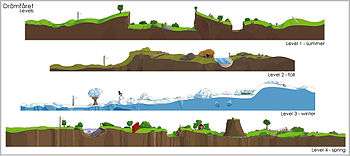Level (video games)
A level, map, area, stage, world, track, board, floor, zone, phase, mission, episode, or course in a video game is the total space available to the player during the course of completing a discrete objective. Video game levels generally have progressively increasing difficulty to appeal to players with different skill levels.[1] Each level presents new content and challenges to keep player's interest high.[1]
| Part of a series on the: |
| Video game industry |
|---|
|
Activities/jobs
|
|
|
Types |
|
Related |
In games with linear progression, levels are areas of a larger world, such as Green Hill Zone. Games may also feature interconnected levels, representing locations.[2]
Level design
Level design or environment design is a discipline of game development involving creation of video game levels—locales, stages, or missions.[3][4][5][6]
_level_layout.png) Layout of a level in the puzzle game Edge
Layout of a level in the puzzle game Edge Different levels in a 2D computer graphics game layout
Different levels in a 2D computer graphics game layout
Level editor

| Wikimedia Commons has media related to Level editors. |
A level editor (also known as a map, campaign or scenario editor) is a game development tool used to design levels, maps, campaigns and virtual worlds for a video game. An individual involved with the creation of game levels is a level designer or mapper.
In some cases, the creator of a video game includes built-in level editing tools, for example, a track editor for a racing game. Other times they may release an official level editor for the game as a separate application. Sometimes players of the game create fan-made level editors.
One of the first 3D games which became popular partially due to level editors and fan-made content was Doom. The creation of various third-party editors led to the birth of an online community trading fan-made maps.[7]
A level editor is often limited to creating levels for only a certain game engine. Developing a level editor takes a lot of time and it is more time and cost efficient to release multiple games using the same engine instead of developing a new engine and level editor for each game. Level editors offer some limited scope of content creation, but in the case of gaming industry solutions the scope is very large allowing an entire game to be created without the need for much support from a programming team. To make larger changes to a game than simply adding new levels, a software development kit (SDK) is sometimes needed.
Construction set
In the early years of video-gaming, some games came with a utility called a "construction set". This was similar in many ways to a level-editor. Some games used them to create extra levels, whereas others (like the Shoot-'Em-Up Construction Kit) used them as a means to create a game rather than be a game in itself.
Bonus stage
A bonus stage (also known as a bonus level or bonus round) is a special level within a video game designed to reward the player or players, and typically allows the player to collect extra points or power-ups. Bonus stage either have no enemies or hazards, or replace the normal penalties for being struck by enemies or hazards with simply being thrown out of the bonus stage. Many bonus stages need to be activated or discovered in some manner, or certain conditions must be satisfied to access them. Otherwise, they appear after the player has completed a certain number of regular stages.[8]
See also
- Minigame
- Tutorial (video gaming)
- Online creation
- Mod (video gaming)
- ROM hacking
Sources
- Scott Rogers (16 April 2014). Level Up! The Guide to Great Video Game Design. Wiley. ISBN 978-1-118-87719-7.
- Lewis Pulsipher (25 July 2012). Game Design: How to Create Video and Tabletop Games, Start to Finish. McFarland. ISBN 978-0-7864-9105-6.
- Guy W. Lecky-Thompson (1 January 2008). Video Game Design Revealed. Cengage Learning. ISBN 1-58450-607-5.
- Bates, Bob (2004). Game Design (2nd ed.). Thomson Course Technology. ISBN 1-59200-493-8.
- Brathwaite, Brenda; Schreiber, Ian (2009). Challenges for Game Designers. Charles River Media. ISBN 1-58450-580-X.
- Moore, Michael E.; Novak, Jeannie (2010). Game Industry Career Guide. Delmar: Cengage Learning. ISBN 978-1-4283-7647-2.
- Oxland, Kevin (2004). Gameplay and design. Addison Wesley. ISBN 0-321-20467-0.
- Shahrani, Sam (April 25, 2006). "Educational Feature: A History and Analysis of Level Design in 3D Computer Games". Retrieved 5 January 2011.
References
- Schell, Jesse (2014). The Art of Game Design: A book of lenses. Pittsburgh, Pennsylvania, USA: CRC Press. pp. 120, 252. Retrieved 30 December 2017.
- McGuire, Morgan; Jenkins, Odest Chadwicke (2009). Creating Games: Mechanics, Content, and Technology. Wellesley, Mass.: AK Peters. p. 104. ISBN 978-1-56881-305-9.
- Oxland 2004, pp.21-22,126
- Bates 2004, p.107
- Brathwaite, Schreiber 2009, p.5
- Shahrani 2006, part I
- Herwig, Adrian; Paar, Philip. "Game Engines: Tools for Landscape Visualization and Planning?" (PDF). CiteSeerX 10.1.1.134.75. Archived from the original (pdf) on 2017-08-09. Retrieved 2020-02-07.
- "The Next Generation 1996 Lexicon A to Z". Next Generation. No. 15. Imagine Media. March 1996. p. 30.
Typically, bonus levels are either hidden and require discovery or appear after a certain number of regular levels have been completed.